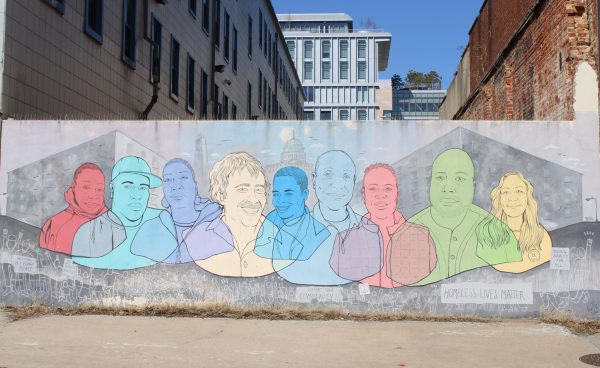Environmentalism in Dubai and DC
Visions of Dubai include enormous malls, vending machines that dispense gold and a police force that drives around in Lamborghinis. Rarely does environmental sustainability come to mind when thinking of this oasis in the Arabian Peninsula, where residents do not even turn off their cars as they get gas pumped.
As the world urbanizes, environmentalists concern themselves with limiting the carbon footprint of powerful, global cities, such as Dubai and Washington, DC.
On the other side of the world, DC tells a different story. Many Washingtonians strive for environmental sustainability, religiously recycling and using public transportation to reduce carbon emissions
According to the Dubai Statistics Center and the U.S. Census Bureau, both Dubai and DC have comparably high GDPs per capita, at about $45,000 per person. Though environmentalism is often considered an upper-class issue, the cities’ respective residents approach the issue very differently.
The Kuznets Curve seeks to explain the relationship between wealth and ecology. The x-axis represents income, and the y-axis represents the level of environmental degradation, or the deterioration of natural resources such as land, air and water. An interesting bell curve forms. Areas with very low and very high income levels have the highest levels of environmental degradation.
In his book “Environment and Society,” Paul Robbins, environmental politics expert, explains the Kuznets Curve further.
“This theory predicts that environmental impacts rise during development, only to fall after an economy matures,” Robbins said.
While the Kuznets Curve is helpful as a guide, it does not always ring true in reality, according to Malini Ranganathan, a global environmental politics assistant professor at American University.
“The relationship between wealth and ecology is not clear cut,” Ranganathan said.
As Dubai modernizes its economy, the level of environmental degradation should level off and begin to decline, according to the Kuznets Curve, but that is yet to happen. Ranganathan also stressed the importance of per capita consumption.
“America has a very high per capita carbon footprint,” Ranganathan said, noting that Dubai is also “an extreme case.”
The income gap in Dubai also causes political issues, according to Ranganathan. Poor workers built Dubai’s extravagancies, enjoyed by billionaire sheikhs and rich tourists from around the globe. As long as Dubai’s disenfranchised populations remain marginalized, environmental sustainability will remain on the backburner.
In DC, Ranganathan points to the District’s 5-cent bag tax as an environmental success. She said she was surprised at how well it took hold, especially because of how minimal the tax is. According to Ranganathan, the visibility of the reusable shopping bag campaign made it successful and even trendy, as reusable bags have become available in every color and pattern imaginable.
Lennee Lazala, a resident of Dubai for more than 20 years, says she has watched the area suffer from a host of environmental problems since she moved there.
“I’m sure [the government doesn’t] want to admit it,” she said.
In older areas of the city, in neighborhoods such as Karama and Satwa, sewage problems arise when Dubai receives its annual rainfall. Lazala’s husband, Ronnie, added that Dubai has problems with “a lack of natural freshwater, desertification and pollution.”
Khizer Baig is a sophomore at Boston University who lived in Dubai for almost four years. He also voiced concerns about Dubai’s environmental policies
“Dubai’s primary environmental struggle is with water,” he said. “Water is very expensive for non-drinking purposes and desalination is still a very expensive process.”
Desalination is the process by which water is taken from the ocean and the salt is filtered out, making water fit for agricultural and human consumption. The process, however, causes huge amounts of salt to be dumped into the sea, negatively impacting marine organisms.
In an interview with Water & Wastewater International, an online news source dedicated to water and technology, Saeed Mohammed Al Tayer, CEO of the Dubai Electricity and Water Authority, said that the DEWA desalinates about 470 million gallons of water daily. Much of Dubai’s oil money is dedicated to desalination, causing the oceans to be filled with an excess of chloride, heavy metals and salts. This, along with the lack of recycling, leads to major environmental problems in Dubai.
Baig’s family rarely recycles in Dubai.
“We didn’t recycle our usual trash, but when we had a lot of recyclables from a shipment we would be sure to recycle them,” he said.
Baig also pointed out that the insufferable hot and humid weather in Dubai makes walking and biking around the city impossible. He also never used public transit because it didn’t reach close enough to his home.
“They do not serve tap water in Dubai, so I would only drink bottled water when not at home,” he said. However, Baig’s family, like many in Dubai, relied on large plastic water jugs delivered by Nestléfor water use at home. While Baig and other Dubai residents may not consider these jugs traditional “bottled water,” they are still processed in factories and contribute to waste problems caused by water bottle usage worldwide.
According to the Dubai Statistics Centre, about 80 percent of Dubai’s population consists of expatriates, people who temporarily reside in a country other than their home country. Many live in Dubai for just a few years at a time. The population has little motivation to invest in their community.
“Essentially, people do not feel committed, integrated and responsible enough to want to make a change,” Baig said.
The Royal Geographic Society, a UK based think tank, found Dubai residents use twice as many resources as the average British person.
DC’s largest environmental problem is pollution. The DC Environmental Network’s agenda includes cleaning up rivers, planting more trees, combatting climate change and encouraging schools to serve local organic food.
Nearby the Potomac and Anacostia Rivers, pollution has been rampant, but it has improved in recent years due to government and community action. The 5-cent bag tax was enacted partially to reduce plastic bag waste that ended up in these rivers.
Like many DC residents, American University sophomore Kaitlyn Kessler consciously recycles and takes reusable shopping bags with her when she shops.
“I don’t buy water bottles, ever,” Kessler added.
Instead, she fills her reusable water bottle. Kessler, along with many environmentally-conscious AU students, often rides public transportation, a greener way to commute.
As Washington has already realized, Dubai is quickly learning that it cannot sustain its growing population on its limited resources. Dubai’s Electricity and Water Authority has enacted conservation campaigns to encourage residents to use less water. These initiatives involve cleaning beaches and constructing green buildings, but there is still much to be done.











